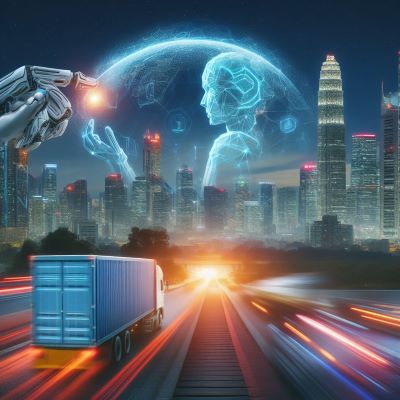Remember the days when you clicked “order” and then waited weeks for your package to arrive? Well, those days are rapidly fading in the rearview mirror. Technological advancements are surging forward at an incredible pace, and logistics, the vital thread of global trade, is undergoing a renaissance. Leading this transformation is a powerful trio of innovations: Artificial Intelligence (AI), Electric and Autonomous Vehicles, and Drones.
Imagine a scenario: super-intelligent algorithms optimize truck routes across continents, predicting traffic jams and weather patterns before they occur. Fleets of autonomous vans silently navigate city streets, delivering goods with pinpoint precision and zero emissions. Meanwhile, agile drones zip through the air, delivering urgent medical supplies or that must-have gadget you just ordered, all within the hour. This isn’t science fiction, but the real future of logistics knocking on the door.
AI has the ability to learn, analyze, and make decisions based on massive amounts of data. In logistics, this translates to incredible potential for increased efficiency and productivity. Algorithms can analyze real-time traffic information, weather forecasts, delivery schedules, vehicle status, historical data, and even social media sentiment to predict consumer demand fluctuations. Based on this comprehensive picture, they can plan optimal routes, minimizing empty miles and fuel consumption. Forget frustrating traffic jams and delays – AI will get you to your destination faster and more efficiently.
For instance, imagine a long-haul truck driver embarking on a cross-country journey. Traditionally, this driver would rely on experience and intuition to navigate the route. Now, enter AI-powered route optimization software. This software analyzes real-time and historical traffic data, considering factors like accidents, construction zones, and weather patterns. It then suggests the most efficient route, taking into account factors like fuel efficiency and estimated delivery time. This not only saves companies money on fuel costs but also reduces overall delivery times.
 Electric and Autonomous Vehicles are the next stars on the stage. Imagine a fleet of “green” trucks and vans silently gliding through streets, emitting zero harmful emissions and saving the environment. Take it a step further – autonomous vehicles can travel nonstop, without needing driver breaks, further optimizing goods delivery. Here, the benefits extend beyond just efficiency; they contribute to a cleaner, more sustainable future.
Electric and Autonomous Vehicles are the next stars on the stage. Imagine a fleet of “green” trucks and vans silently gliding through streets, emitting zero harmful emissions and saving the environment. Take it a step further – autonomous vehicles can travel nonstop, without needing driver breaks, further optimizing goods delivery. Here, the benefits extend beyond just efficiency; they contribute to a cleaner, more sustainable future.
Companies like Daimler and Tesla are at the forefront of developing electric and autonomous trucks. Daimler’s Freightliner eCascadia is a fully electric semi-truck currently undergoing real-world testing. Tesla’s Semi, another fully electric offering, boasts a range of over 500 miles on a single charge, making it ideal for long-haul transportation. These electric giants are not only reducing emissions but also lowering operating costs for companies due to the elimination of fuel expenses.
Drones, agile and quick, are ideal for deliveries to hard-to-reach locations or urgent packages. Imagine a scenario where life-saving medical supplies are delivered by drone to a remote village after a natural disaster. Or perhaps you need a critical replacement part for a manufacturing plant, and a drone delivers it within the hour, preventing costly downtime. These are just a few examples of the potential applications for drone technology in logistics.
Amazon, a pioneer in innovation, is already putting drone delivery to the test with their “Prime Air” program. The program utilizes autonomous drones to deliver packages in select regions. The goal? To have drones deliver packages within 30 minutes of ordering! While regulatory hurdles still exist, Amazon’s initiative demonstrates the immense potential of drone delivery for revolutionizing last-mile logistics.
But speed and efficiency aren’t everything. AI can also be used to automate the fulfillment process in warehouses. Robotic arms, guided by intelligent algorithms, can efficiently pick, pack, and transport goods, reducing the need for manual labor and increasing accuracy. Imagine a warehouse bustling with activity, not with human workers, but with a ballet of robotic arms precisely handling and sorting goods. This not only improves efficiency but also reduces the risk of workplace injuries.
However, this technological leap also comes with a set of legal challenges. Regulation of autonomous vehicles and drones is ongoing. The United States has a patchwork of regulations at the federal and state level. The European Union adopted regulations for civilian drones in 2019, while China, a leader in drone technology, has also implemented strict regulations. Countries of the former Yugoslavia are just beginning to grapple with this topic, and it’s crucial for them to harmonize their laws with technological advancements to enable safe and legal use.
Furthermore, there are concerns about privacy and security. Autonomous vehicles generate vast amounts of data, and it’s essential to ensure this data is securely stored and used. Additionally, airspace safety with a proliferation of drones requires careful consideration and clear regulations.
Despite these challenges, the future of logistics is undeniably bright. AI, electric and autonomous vehicles, and drones have the potential to revolutionize the way we deliver goods. This transformation promises not only faster deliveries and lower costs but also a more sustainable future with reduced emissions. As regulations catch up and public trust grows, we can expect to see these technologies seamlessly integrated into our daily lives. Buckle up, the future of logistics is arriving fast!
